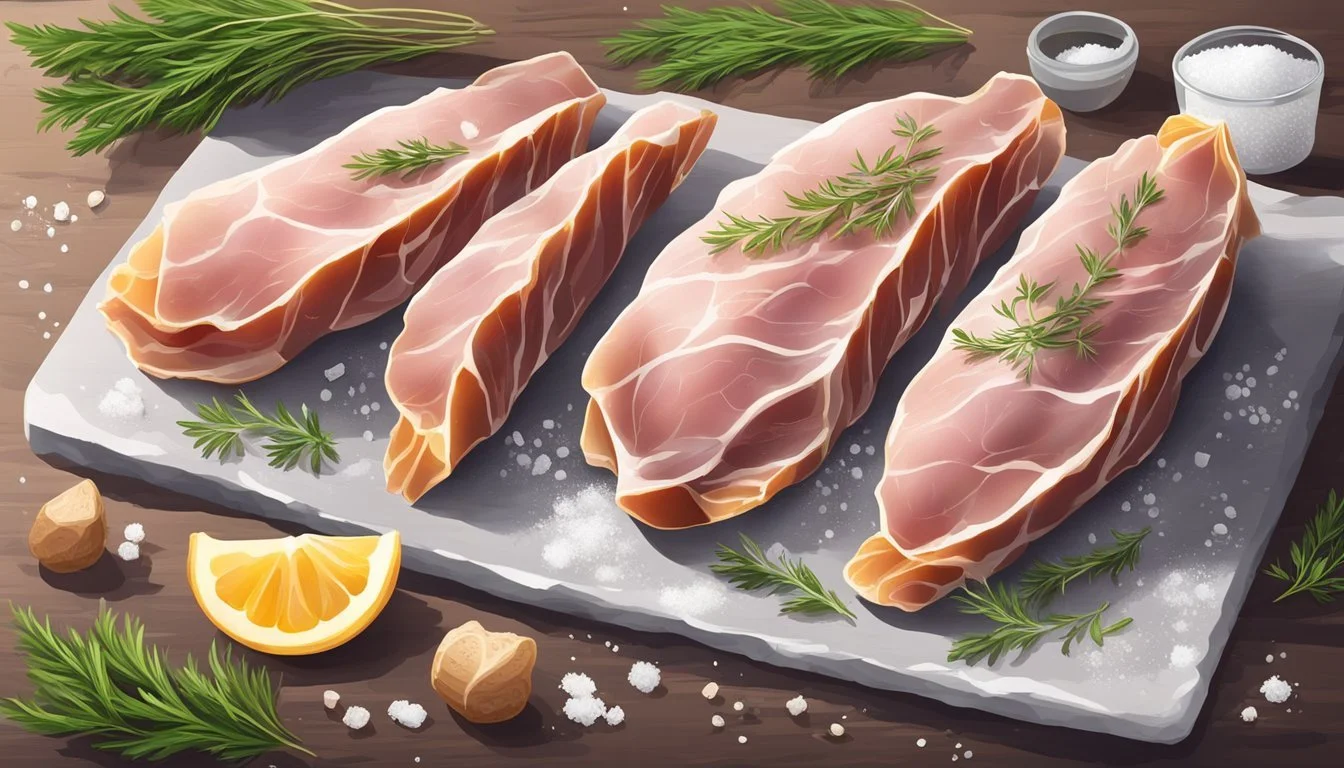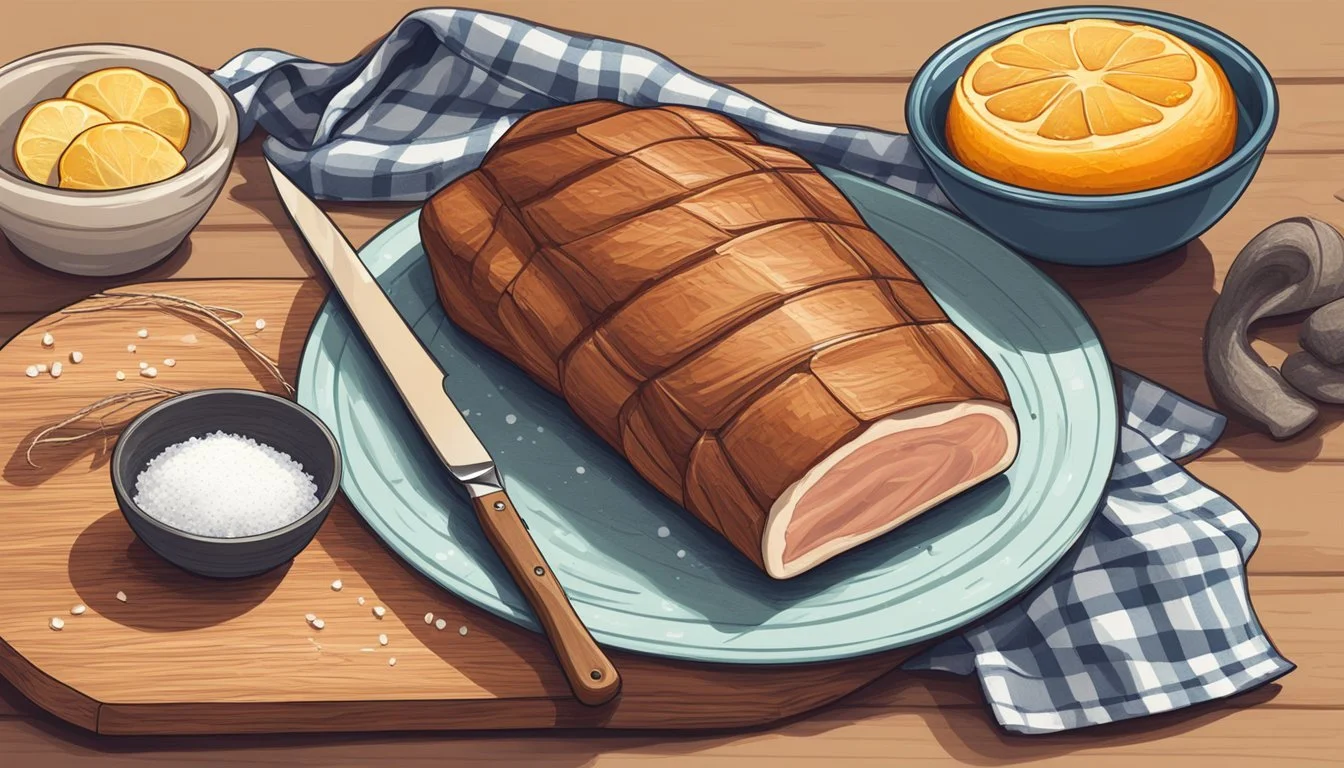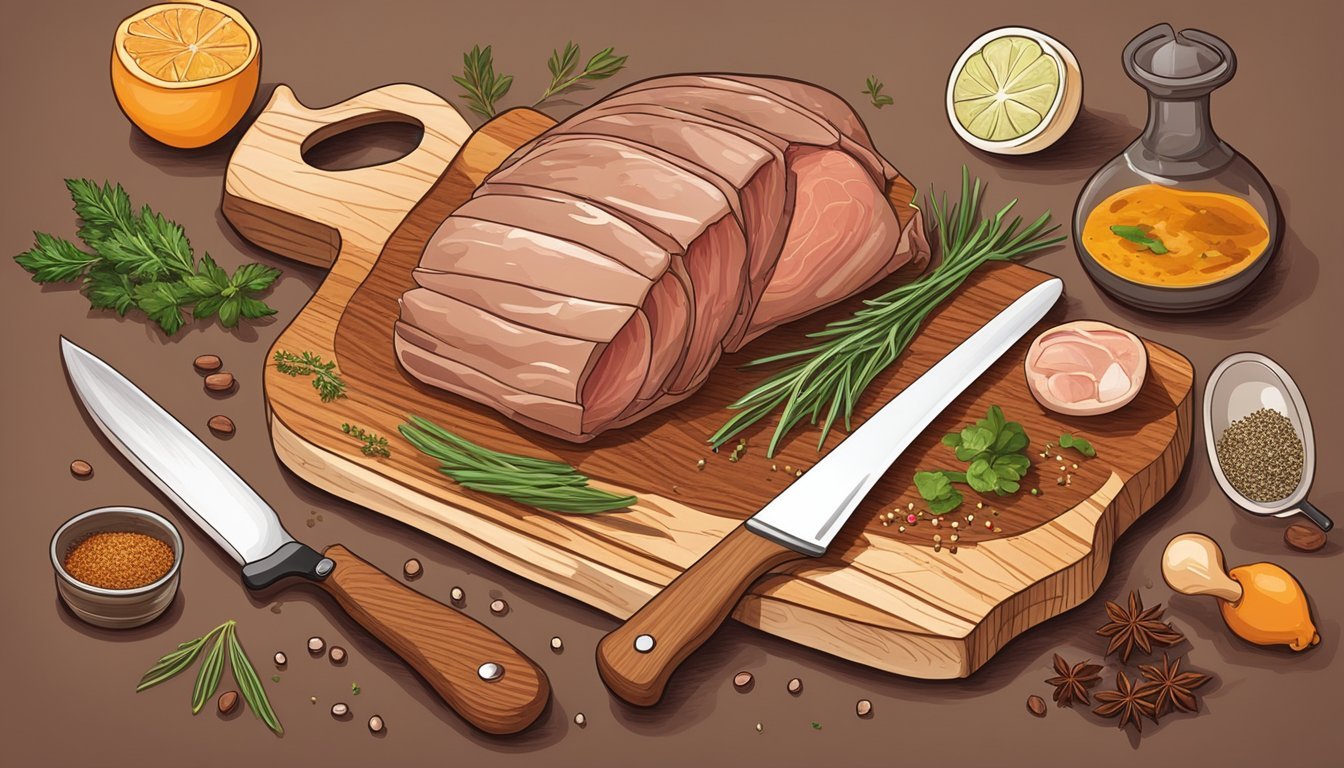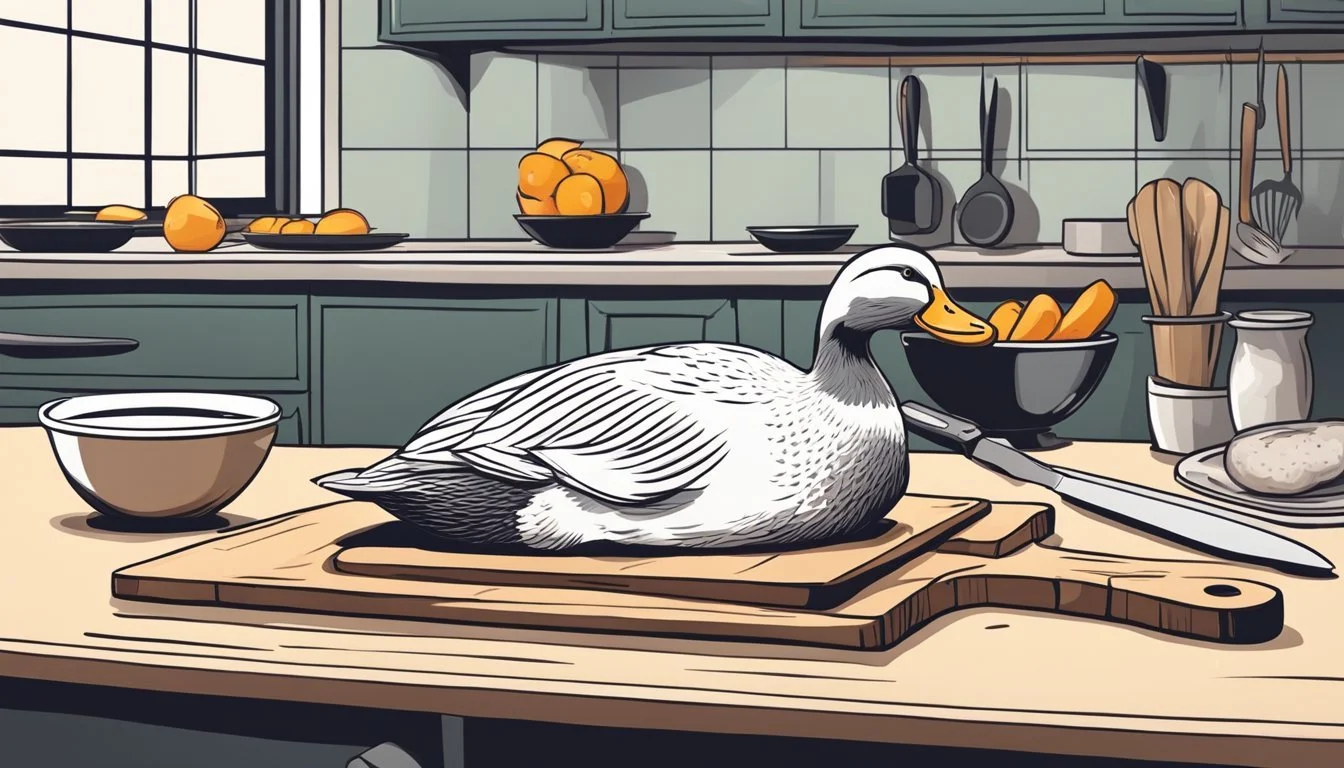The Ultimate Guide to Making Duck Prosciutto at Home
Simple Steps to Gourmet Charcuterie
Duck prosciutto, a delicacy in the world of charcuterie (What wine goes well with charcuterie?), is a masterpiece of simplicity and flavor. This cured meat harnesses the power of salt and time to transform duck breast into a luxurious dish that rivals traditional pork prosciutto. The process is accessible enough for home cooks to master, requiring minimal equipment and space. Making duck prosciutto at home invites one into an age-old tradition of food preservation, enabling the creation of a rich, savory treat that can elevate any meal.
The key to exceptional duck prosciutto lies in the quality of ingredients and the precision of the method. Choosing high-quality duck breasts and carefully balancing the salt and optional curing agents is a critical step. The curing phase, where the meat is buried in salt and kept refrigerated, is followed by a drying period essential for developing the prosciutto's characteristic texture and concentrated flavor. These stages, although simple, demand attention to detail to ensure that each slice of home-crafted prosciutto offers a perfect meld of taste and tenderness.
With patience and care, anyone can produce exquisite slices of duck prosciutto. It serves not only as a testament to the crafter's skill but also as a gateway to a world of culinary possibilities—complementing a charcuterie board, enriching a salad, or simply enjoyed on its own. The process, both an art and a science, brings with it the gratification of creating a gourmet ingredient and the joy of sharing it with others.
Understanding Duck Prosciutto
Duck prosciutto is a rich, flavorful delicacy that mirrors its pork counterpart in technique, yet offers a unique taste experience. The art of curing meats extends back centuries, providing a canvas that contrasts the traditions of pork prosciutto with fowl-based variations.
Historical Backdrop
The tradition of curing meat dates back to ancient times, a preservation technique vital for survival before refrigeration. Italy is renowned for its pork prosciutto, with each region showcasing its distinct version. Duck prosciutto, although less common, emerged as a sophisticated alternative, particularly in areas of Venice and the Jewish community, where dietary laws restricted the consumption of pork. Goose prosciutto also shares a similar history, especially within these communities.
Culinary Significance
Duck prosciutto holds a coveted place in the realm of charcuterie, embraced for its captivating flavor and the skill required to craft it. Unlike pork prosciutto which is often eaten on its own, duck prosciutto is typically featured in dishes as an accentuating flavor due to its robust profile. Chefs and gourmands appreciate its versatile nature, whether served thinly sliced atop a salad or as part of an intricate appetizer.
Comparison with Other Cured Meats
Duck prosciutto stands distinct from pork prosciutto not only in the type of meat used but also in subtleties of flavor and texture. The fat content and distribution in duck breast offer a uniquely succulent and rich taste, generally richer than that of pork. In the context of kosher dietary laws, duck prosciutto presents an alternative to pork for those within the Jewish community who adhere to kosher prosciutto guidelines. When compared across the spectrum of cured meats, duck prosciutto is notably tender with a delicate balance of savory and subtly sweet undertones, a testament to the artistry of charcuterie.
Selecting Ingredients
The ultimate duck prosciutto hinges on high-quality ingredients. Each component contributes to the final flavor and preservation of the meat, from the duck breast itself to the precise balance of salts and spices.
Choosing the Right Duck Breast
Selecting the optimal duck breast is the first step in creating excellent duck prosciutto. Moulard duck breasts are often recommended due to their ample size and rich flavor, which is ideal for curing. One should look for firm, plump breasts with skin intact, as this aids in the curing process and contributes to the prosciutto's final taste and texture.
Salt and Curing Salts
For the curing process, both salt and curing salt are essential. Use pickling salt for its fine grain and purity, ensuring even coverage and absorption. Curing salt (often referred to as "pink salt" or "Cure #2") contains sodium nitrate and should be used with precision—typically at 0.25% of the meat's weight. This inhibits bacterial growth and contributes to the meat's classic color and flavor.
Ingredient Purpose Quantity Pickling salt Draws out moisture, cures Varied (cover breast) Curing salt Preserves, adds flavor/color 0.25% of duck breast weight
Herbs and Spices
The addition of herbs and spices can significantly enhance the character of duck prosciutto. Thyme and bay leaves provide a robust, aromatic backdrop, while black pepper adds a warm, pungent kick. Some prefer the inclusion of ground juniper berries for their slightly resinous, fruity note. These should be used sparingly, as their flavors concentrate during curing.
Herb/Spice Function Suggested Quantity Thyme Aromatic base 1-2 tsp, dried Bay leaves Depth of flavor 2-3 whole leaves Black pepper Heat, aroma 1 tbsp, freshly cracked Juniper berries Fruity sharpness 1 tsp, crushed
Each ingredient should be prepared and measured with care to maintain the balance between preserving the duck breast and infusing it with the desired flavors.
Preparation Steps
Creating duck prosciutto at home involves careful preparation to ensure the flavors are absorbed and the meat cures properly. Each step lays the foundation for a deliciously rich and savory final product.
Trimming the Duck
One must begin by carefully preparing the duck breasts. Trimming any excess fat to ensure an even thickness can help in the curing process, although leaving enough fatty skin on the breast is vital for flavor development. Each breast should be handled with care to maintain its integrity throughout the curing process.
Preparing the Cure Mixture
The cure is crucial for both flavor and preservation. A typical cure mixture includes:
1 cup of kosher salt
1/4 cup of brown sugar (which helps balance the flavors)
These ingredients should be mixed thoroughly in a bowl. To adjust the mixture for larger quantities or personal taste preferences, maintaining the ratio of salt to sugar is essential. For a subtle spicy hint, one might add 1 tablespoon of ground white pepper to the mixture.
Applying the Cure
Once the cure mixture is ready, the application process is next:
Lay a half-inch layer of the cure mixture in a nonreactive baking dish, ensuring it's large enough to hold the duck breasts without them touching.
Nestle the breasts skin side up on top of the cure.
Generously cover the duck breasts with the remaining cure, making certain that both meat and fatty skin are enclosed.
Store the dish in the refrigerator. The length of curing varies, typically 24 hours for a standard-size duck breast.
During this time, check the breasts to monitor progress, ensuring they are firming up appropriately without becoming too hard. After curing, they should be rinsed thoroughly to remove excess salt and then dried before moving on to the next stage of the process.
Curing Process
The curing of duck prosciutto is a critical step that transforms the raw meat into a delicately flavored delicacy through precise refrigeration, applied weight, and careful monitoring.
Refrigeration Techniques
Refrigeration is vital in slowing bacterial growth and allowing the cure to penetrate evenly. The duck breast must be placed in a non-reactive container, such as glass or stainless steel, or a vacuum bag, to maintain an optimal curing environment. This container or bag is then stored in the refrigerator, typically set between 34°F and 38°F (1°C and 3°C), which provides the cold but not freezing conditions necessary for the curing process.
Weight and Pressing
Applying weight to the duck breast helps it cure evenly by pressing out any residual moisture. This can be done by wrapping the breast in plastic wrap and setting a weight on top – often another heavier container or specially designed press. The weight should be consistent and moderate, to avoid crushing the meat while still aiding in moisture removal and ensuring a firm texture.
Monitoring the Cure
Closely observing the duck breast during the curing period is essential for achieving the desired flavor and texture. Humidity levels should be monitored and maintained around 60-70% to prevent the surface from drying out too quickly and to allow the meat to cure properly. One should routinely check the firmness of the meat, with the curing time typically spanning 24 hours to a week, depending on the specific recipe and size of the duck breast.
Drying and Aging
Drying and aging are critical stages in the production of duck prosciutto, where the flavor intensifies and the texture becomes ideal. Proper techniques and conditions ensure a successful dry-cured delicacy.
Preparing for Drying
One must begin by wrapping the cured duck breast in cheesecloth, which protects the meat while allowing air to circulate. Then, one secures the bundle with butcher's twine, a process essential for hanging the meat.
Aging Conditions
The aging environment is crucial for developing the distinctive flavor and texture of duck prosciutto. The ideal conditions include:
Temperature: Mature the meat at a cool temperature, typically between 54°F and 60°F.
Humidity: Maintain a relative humidity of approximately 60-70%.
Airflow: Ensure good air circulation around the meat to prevent the formation of undesirable mold.
One may use a dedicated curing chamber or modify a refrigerator with the necessary equipment to monitor and maintain these conditions.
Testing for Readiness
One assesses the readiness of duck prosciutto through touch and sight. The meat should feel firm throughout, and upon inspection, it may exhibit a white mold, an indication of proper aging. If the meat has hardened uniformly, it typically signals that the duck prosciutto is ready to be enjoyed.
Slicing and Storing
After curing, the duck prosciutto’s flavors are best showcased when it is sliced thinly and stored properly to preserve its quality. Proper technique and storage solutions are essential for extending the enjoyment of homemade duck prosciutto.
Slicing Techniques
Thin Slicing: To achieve wafer-thin slices, one needs a very sharp knife or a deli slicer. The duck prosciutto should be chilled to make slicing easier. Gentle, consistent pressure should be used to slice thinly without tearing the meat. A suction cup meat holder can be very helpful for stability.
Angle and Thickness: Slicing at a slight angle increases the surface area of each slice, enhancing the tasting experience. Slices should ideally be almost translucent.
Patience: The process shouldn't be rushed; patient slicing ensures intact, visually appealing slices that retain their texture and flavor.
Storage Solutions
Short-Term Storage: For short-term storage, wrap the sliced duck prosciutto in parchment paper and then in plastic wrap. Refrigerate and consume within a few days.
Vacuum Sealing: For long-term storage, vacuum sealing individual portions is ideal. This method reduces air exposure and prevents spoilage. Sealed packages can be stored in the refrigerator for several weeks.
Avoiding Moisture: It's crucial to keep the cured duck dry. Any moisture can lead to spoilage. Before sealing, one should pat down slices with a paper towel if necessary.
Serving Suggestions
Duck prosciutto, a luxurious and flavorful cured meat, shines as a standalone delicacy yet pairs beautifully with a variety of accompaniments. Elevating a simple dish or a charcuterie board, this cured specialty serves as a versatile ingredient that enhances the gastronomic experience.
Pairings and Accompaniments
Charcuterie Plate: Duck prosciutto adds a rich, savory element to any charcuterie spread. It pairs particularly well with:
Cheeses: Aged Parmesan, creamy Brie, or a robust Blue cheese.
Fruits: Fresh slices of melon or figs provide a sweet balance to the saltiness.
Pickles: Cornichons or other pickled vegetables add a tart, acidic note.
Salad Integration: Duck prosciutto can be thinly sliced and incorporated into salads (What wine goes well with salads?), offering a burst of flavor and a hint of luxury. It pairs excellently with:
Greens such as arugula, which has a peppery note.
Nuts like walnuts or almonds for a crunch.
A light vinaigrette to complement the rich duck.
Presentation Tips
For an eye-catching presentation:
Thin Slices: Use a sharp knife to cut the prosciutto into thin, almost translucent slices.
Arrange with Care: Lay the slices out in an overlapping fashion or roll them up for an elegant look.
Board Design: On a wooden board, create visual contrast with the pale duck against darker charcuterie elements.
Plate Individual Servings:
A small stack of prosciutto atop a cracker or crostini, with a thin slice of melon and a small dab of soft cheese, makes for a sophisticated appetizer.
When featuring as part of a first course or appetizer plate, consider garnishing with a sprig of fresh herbs for color.
By considering these pairing and presentation elements, one ensures that duck prosciutto is enjoyed to its fullest, its rich flavor profile elegantly woven into the dining experience.
Nutritional Information
Duck prosciutto, a delicately cured meat, provides a unique blend of nutrients that varies depending on the portion size and the duck's diet. Typically, a one-ounce (28 grams) serving contains a concentrated source of protein, alongside a moderate amount of fat, and minimal carbohydrates.
Nutrient Amount per serving Calories 60-80 Protein 8-10g Fat 2-4g Saturated Fat 0.5-1g Carbohydrates 0-1g Fiber 0g Sodium 500-900mg Iron 1-2mg
The curing process of duck prosciutto often involves rolling the meat in a salt-based mixture, resulting in a high sodium content. Connoisseurs should take this into account, especially those monitoring their salt intake for health reasons.
In terms of protein, it serves as an excellent source, with its density being a result of the dehydration process in curing. This makes duck prosciutto a filling option for a small portion.
The iron content in duck meat can contribute to normal oxygen transport in the blood, especially significant for individuals prone to anemia.
Fats, primarily unsaturated with a small amount of saturated fat, provide energy and taste, while fiber is negligible as duck prosciutto is a fiber-free food.
Duck prosciutto is a low-carbohydrate food, which may appeal to those on ketogenic or other low-carb diets. It is also gluten-free naturally, which suits those with gluten sensitivities or celiac disease.
They should enjoy duck prosciutto in moderation, like any cured meat, mainly due to its high sodium content and because it is a more indulgent food with a dense nutrient profile.
Safety and Hygiene
In the process of making duck prosciutto at home, safety and hygiene stand paramount to ensure a high-quality and healthy end product. Adhering strictly to safety measures helps prevent foodborne illnesses and spoilage.
Avoiding Contamination
One must be vigilant to prevent contamination throughout the curing process. Contamination can occur through several vectors, including:
Unsanitized equipment: All tools, cutting boards, and surfaces must be sanitized before coming into contact with food.
Improper handling: Hand washing is critical before handling the meat, as well as after touching any potential contaminants.
Cross-contamination: Keep raw duck separate from other food items to avoid cross-contamination.
It's also essential to start with a fresh duck breast that has been stored properly prior to use.
Risks and Preventative Measures
Specific risks in preparing duck prosciutto include the growth of unwanted mold and the proliferation of bacteria. To mitigate these risks, one can employ several preventative measures:
Temperature control: The duck should be cured in the refrigerator at a consistent and safe temperature below 5°C (41°F).
Curing agents: Using the correct amounts of salt and curing salts like Cure #2 helps inhibit bacterial growth.
Observation: One should inspect the duck breast daily during the curing process, looking for any signs of spoilage or unusual mold.
Rinsing: After curing, the duck breast should be thoroughly rinsed off to remove excess salt, thereby preventing the surface from becoming overly hospitable to unwanted mold growth.
By following these specific steps vigilantly, one can greatly reduce the risks of contamination and spoilage, ensuring a safe and enjoyable homemade duck prosciutto.
Creative Variations
In crafting duck prosciutto at home, one can elevate this classic delicacy by experimenting with alternative seasonings and unique serving ideas that complement its rich flavors.
Alternative Seasonings
Homemade duck prosciutto offers a canvas for culinary creativity. Traditional mixes can be enhanced with the robust smokiness of smoked paprika or the refreshing tang of white wine vinegar. For a more herbaceous note, marjoram can be ground using a spice grinder and combined with other herbs to create a customized herb mix. For those who favor the anise-like flavors of fennel, incorporating ground fennel or lightly crushed fennel seeds can add a new dimension to the curing process.
Seasoning Blend Example:
1 tsp smoked paprika
1 tsp ground marjoram
1/2 tsp ground fennel
Mix these together and rub onto the duck breast before curing
Unique Serving Ideas
Duck prosciutto can transform an ordinary meal into an extraordinary one with thoughtful presentation and pairing. Serve thinly sliced duck prosciutto on a charcuterie board, where its rich taste is contrasted with the brightness of pickled vegetables, drizzled with white wine vinegar. Another sophisticated approach is to wrap slices of prosciutto around ripe figs or melon, letting the sweetness of the fruit balance the savory depth of the meat.
Serving Suggestions:
Wrap slices around grissini sticks for a crisp texture contrast
Top fresh salads with thin strips of prosciutto to enhance flavor profiles
Expert Tips and Tricks
In crafting homemade duck prosciutto, enthusiasts can face difficulties and seek expert advice for that impeccable result. The following pointers present solutions to common issues and glean wisdom from seasoned professionals.
Troubleshooting Common Issues
Excess Saltiness: If the duck prosciutto tastes too salty, one should soak the breasts in cold water for a couple of hours before the final drying phase. This will leach out some of the salt. It is crucial to then thoroughly dry the meat on a baking sheet lined with paper towels.
Uneven Curing: Meat should be massaged evenly with the curing mix to prevent uneven texture. Utilize a precise mix of salts and dark brown sugar for consistent cure distribution.
Advice from Professionals
Michael Ruhlman suggests that using a combination of salt and a little sugar not only seasons the meat but also helps in drawing out moisture more effectively.
Portuguese culinary traditions emphasize the importance of quality ingredients. Selecting fresh, high-quality duck breasts ensures the best final prosciutto.
Expert smokers often recommend a gentle touch of aromatic wood smoke after curing and before drying to instill a subtle yet rich flavor profile.
Further Uses of Duck Prosciutto
Once you have mastered the art of making duck prosciutto at home, its versatility in culinary applications becomes evident. It's a sophisticated addition that can elevate the simplest recipes to gourmet experiences.
Incorporating into Cooking
One can incorporate duck prosciutto into various dishes to add a rich, savory flavor. Thinly slicing the prosciutto allows it to integrate seamlessly into other recipes, imparting its unique taste without being overpowering.
Salads: A few slices of duck prosciutto can enrich a salad's flavor profile.
Pastas: Chopped or torn prosciutto works well in creamy pasta sauces or as a garnish on top.
Duck prosciutto also complements the creamy texture of butter when spread on bread or crackers, creating a fusion of flavors that resonates with paired options like fruits and cheeses.
Innovative Recipes
The capacity of duck prosciutto to enrich recipes is extensive. Chefs and home cooks alike can get creative, utilizing this ingredient in innovative ways.
Duck Jerky: One can create duck jerky by baking thinly sliced prosciutto until it becomes dehydrated and chewy.
Stew: Pieces of prosciutto will add depth to stews, imbuing them with a complex, umami-packed taste.
Recipe Type Suggested Use of Duck Prosciutto Charcuterie Boards Accompany with tangy pickles and soft cheeses. Bruschetta A fine topping with ripe tomatoes and basil. Risotto Stir into creamy risottos for a luxurious finish.
Each application not only utilizes the distinct flavor of duck prosciutto but also contributes to creating dishes that are memorable for their taste and inventive use of this cured specialty.






